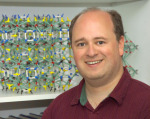Cadmium tricyanomethanide tetramethoxyborate (try saying that three times!)
More tales from the Batten lab.
What does it look like?

What is it?
The best way to grow nice crystals is for the crystals to form slowly and undisturbed. This allows the molecules to assemble in the most regular fashion they can, with time to correct mistakes in the packing as the crystal grows.
Sometimes, however, crystals take much longer to grow than expected, and are found in crystal growing reactions that normally should have been abandoned and thrown away months beforehand. One such example is the rather complicated structure shown above.
The crystals of Cd(tcm)B(OMe)4.xMeOH took six months to grow, and seemed to appear almost overnight as beautiful and very large elongated octahedral. Note that they didn't grow slowly and evenly over those six months, but rather the solution was completely devoid of crystals for almost all the time, and then suddenly surprise! Huge Crystals!
So what happened? It turns out that the chemistry is probably the key. The structure contains tetramethoxyborate anions, yet no such anions were added to the reaction. Rather, the boron in the anions comes from another anion that was added – tetraphenylborate. It seems that this anion slowly reacted with the methanol solvent to produce the new anion. The concentration of new anion presumably built up over time until there was enough to start growing the crystals. And once it did start growing the crystals, well, it didn't do it in half measures! They're still some of the most spectacular crystals I've ever grown.
Where did the structure come from?
As for the structure itself, it contains a complicated coordination polymer that has small chiral pores running through it. Those pores contain helices of hydrogen bonded methanol molecules. The chiral nature of the coordination polymer, at that time, was very unusual, so the crystals were certainly worth the wait. Sometimes putting off cleaning up your lab bench of 'failed' crystallisation attempts can pay off!
Source: "Solvolysis of [B(C6H5)4]- in methanol to give the chiral coordination polymer Cd(tcm)[B(OMe)4].xMeOH, x ≈ 1.6", S. R. Batten, B. F. Hoskins and R. Robson, Angew. Chem. Int. Ed. Engl., 1997, 36, 636. DOI: 10.1002/anie.199706361
CCDC Refcode: RIVDEF






